Ifton Rhyn Colliery Locomotives.
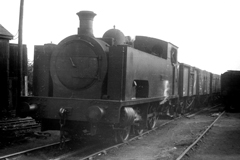
'Unity' HC 1587/27. 0-6-2T Hudswell Clark built 1927. New to Ifton Colliery.
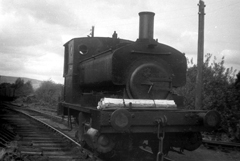
'Piraeus' AB 643/89.0-4-2ST Andrew Barclay built 1889. New to Eckersley, Godfrey and Liddelow (contractors). To Brynkinallt Colliery by 1894 and to Ifton about 1928. Scrapped August 1955.
Loco 6405
No.6405, along with her twin 6404, was built at Swindon in March 1932 under lot 277. They both had 16‘½" x 24" inside cylinders with Stephensons valve gear and a class ‘FA‘ boiler with 165 lbs pressure, 4' 3" diameter by 10' 6" long with a 5' 6" long firebox. The wheelbase was 14' 8" equally divided, the tanks held 1,100 gallons and the weight in working order was 45 tons 12 cwt.
The twins were together for much of their lives, which were spent entirely in the Wolverhampton Division. Both engines went new to Stourbridge, and were still there in January 1934. At some time subsequently 6405 was evidently moved away as she was transferred back to Stourbridge in September 1937. By the begining of 1938 No.6404 had been re-allocated to Birkenhead and 6405 followed during the war; subsequently one used to see them on the Lever Bros. workmen's trains to and from Port Sunlight.
It was in June 1948 that 6405 was sent to Croes Newydd, and she was joined by her twin in February 1949. Both engines were withdrawn in June 1959; 6405 had remained at Croes Newydd but in the end was separated from her twin as 6404 was transferred to Oswestry in March 1959; she was to spend the last three months of her career at the former Cambrian capital.
The GWR had two principal series of pannier tanks. The '5700‘ class was the larger and was based on the old Swindon ‘2700' class which was a tank version of the ‘Dean Goods’ 0-6-0. The modern '9400’ class was a taper boiler version of the ‘5700s’ just as the '2251‘ was a taper boiler version of the ‘Dean Goods‘.
The smaller and lighter panniers were based on the Wolverhampton '2021‘ class and included the '1600' class with 4' 1½" wheels, the '5400‘ class with 5' 2" wheels and the '6400' class with 4' 7½" wheels - both auto fitted for passenger working - and the '7400‘ class which was a non-auto version of the ‘6400s'. The latter engines were intended to work in more hilly districts than the ‘5400' class.
The SLS/MLS RAILTOURS
2a: The Denbighshire Railtour of 6 September 1952
From The Mancunian No.233 March 2003
"A specially chartered train, consisting of two coaches drawn by a tanker type engine, slipped out of Wrexham General Station on Saturday on a three and a half hours exploration of railway lines long closed to regular passenger traffic". So ran the opening paragraph of the report on our fourth railtour published in the 'Wrexham Leader‘ on the 12th September 1952 under the banner headline "Ghost Train rides again". It continued with "and all along the route people stared curiously as it passed, astonished at the presence of a passenger train where none should be, and no doubt speculating as to its origin and purpose."
The tour was due to start at Wrexham at
3.00 pm so passengers had plenty of time to make their own
way to the Principality. Many took the 11.55 am from
Manchester Exchange, others preferred the CLC route using
either the 10.06 am or 12.16 pm trains from Altrincham for
which special cheap day returns were available. A
contingent of members caught the earlier train at
Altrincham (9.48 am ex - Central) and had a pleasant amble
across Cheshire behind a 'Director', and then walked from
Northgate to Chester General where there was time for a
hot soup in front of a welcoming coal fire in the
refreshment room - it was a cold but dry day. We
noted 44941 of Llandudno Junction passing through on a
special train W108 which included the LNWR observation
coach behind the tender and a three-car "Welsh Dragon" set
in the rear.
Then it was off to Wrexham behind 5010 "Restormel Castle" of Stafford Road on the 12.30 pm departure, one of the Birkenhead to Paddington expresses, in plenty of time to meet at 1.45 pm to be escorted round Croes Newydd shed.
We see from the notebook of Harold Bowtell that our then Chairman decided to travel on Friday evening on the 5.35pm from Exchange behind 45048, then on the 8.28 pm Chester to Denbigh with 40589 of Rhyl (probably sub-shedded at Denbigh). Next day Harold caught the three-coach 9.10 am to Corwen hauled by 41169 of Chester shed, but how he next made his way to Weston Rhyn is not revealed. Here he saw ”Richboro" and "Hornet" in the Ifton Colliery shed, the latter under repair, whilst "Unity" arrived with a loaded coal train from the pit. On the main line 6858 "Woolston Grange" passed with a train of suburban stock and 7810 "Draycott Manor" came through on a nine coach Paddington to Pwllheli express. Before leaving Weston Rhyn, "Piraeus" arrived light engine from the colliery where she had been shunting. Then it was off with 0-4-2T No. 1473 and two auto coaches on the 12.52 pm Wrexham.
When we all eventually mustered at the General station we found the railtour train waiting for us in the up bay platform, two nicely cleaned 64 foot push-pull trailers of the latest type less than fifteen months old and finished in the carmine and cream "express" livery. At the front, chimney leading, was auto pannier No. 6405 smartly turned out with the large serrified and shaded initials "GWR" on the tank side. The MLS/SLS headboard was affixed, the shape suiting well the front end of the pannier tank, and we were off at 3.03 pm, just three minutes later than the advertised time. On board were 23 MLS members in a total of 103 passengers, some of whom subsequently were to join our Society.
We set off south, past Croes Newydd, and at Rhos Junction (1 mile 4 chains) we took the right fork on to the single track branch, the speed limit here being 15 mph and this applies all the way through to Rhos. This line had been opened as far as Llwymenion, and from there to Brook Street re-opened on 1st October 1901. We passed through the closed stations at Rhostyllen (1m 59c), noting that the brick station building was in use as a house, and Legacy (2m 76c) where the brick building was a ruin. The level crossing gates here had been opened by special arrangement, normally the guard has to attend. Just beyond the gates the Legacy branch went off to the left, but only the first 285 or so yards was in use as a siding for North Wales Power (Manweb), the remainder of the branch having been closed as long ago as 1917.
At the connection with the Llwynenion brickworks (seen on the right) at 3m 64c we passed on to the Pontcysyllte branch, which had an interesting history. Built about 1810 as a tramroad by the Ellesmere Canal Co, it passed to the Shropshire Union Railways & Canal Co and was then leased by the LNWR who converted it into a railway (as from 30th January 1867) and worked it with one of their own engines. The line north of Wynn Hall was closed in 1879 and the whole route was sold to the GWR on 12th February 1896, who re-laid the track from Wynn Hall to Brook Street about 1899. Regular passenger services between Wrexham and Rhos, which dated from 1901, ceased as from lst January 1931 but football excursions continued to run (until 1953) in connection with Wrexham's home matches and, indeed, onesuch ran on the day of our railtour.
We duly pulled up in Rhos station (4m 18c), which serves the town of Rhosllanerchrugog, just one minute alter the scheduled time of 3.16 pm. Here we all got out to inspect the station and signal box, which were in good condition as they were still in use. We were all back on board for a prompt departure at 3.31 pm. The section as far as Wynn Hall had closed to passengers on 22nd March 1915, having been introduced on 1st May 1905, so this was the first passenger train for 37 years. We went forward cautiously, with a 7 mph speed limit on the sharp curves and a maximum of 10 mph allowed south of Rhos, past the site of Brook Street Halt (4m 36c) and over the crossing manned by the Rhos Porter-Signalman.
From Rhos Junction we had been climbing, with four sections as steep as 1 in 50/52, but now we were falling equally steeply at 1 lin 51/54. We passed the site of Pant Halt (4m 71c), where the brickworks siding controlled by a ground frame seemed still to be in use, and came to a halt at Penyeae crossing whilst the guard unlocked the gates. Then it was through Wynn Hall (5m 36c) of which little remained and, from here, we became the first and only passenger train to ever traverse these metals. A subsequent Camwellian tour in 1959 did not get beyond Pant.
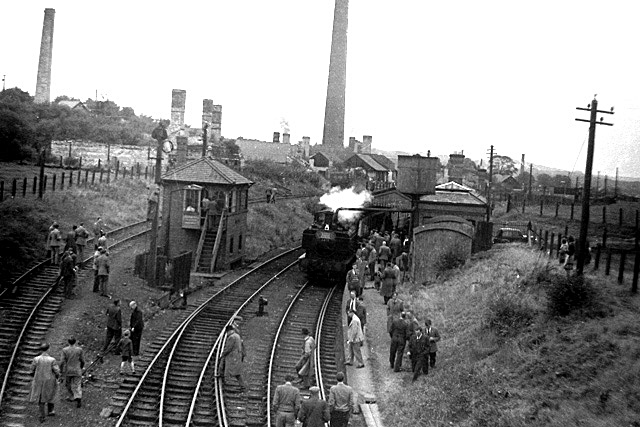
Rhos Station
Again, to quote the 'Wrexham Leader’ when the train stopped at Rhos everyone "promptly swarmed onto the platform, the lines and the surrounding countryside, taking photographs of the train and station from every conceivable angle. There was even an orderly queue waiting to tour the signal box! There was a similar frenzied clicking of camera shutters when the train passed through Wynn Hall, the windows of the coaches slapped by the encroaching foliage of the trees, and came to a halt in the undergrowth outside Plasbennion, much to the amazement of the adult population and the vociferous delight of the children, who had obviously never seen a passenger train in that spot before. They celebrated the occasion with much yelling and excited comings and goings".
We had stopped for the guard to attend to the Plasbennion gates, then ventured forward another half mile down much easier gradients before we pulled up dead again at 3.48 pm (eight minutes behind) just short of the facing points of the junction with the Plasmadoc loop (6m 27c). We were forbidden to take the train over these points. There were no spectators here as we were in the middle of fields well away from the nearest public road. Everyone again clambered out and walked forward to examine the grass embedded loop and just where the Plasmadoc branch crossed the Pontcysyllte line on the level. The GWR Atlas by R A Cooke shows a bridge at this point but it was definitely a level crossing in 1952.
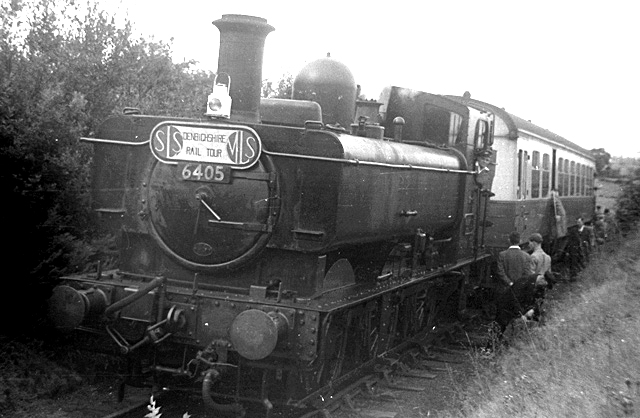
A photo stop and a chat with the driver
A toot on 6405's whistle had us all climbing back on board and we set off at 4.05 pm. (10 down), stopping again for the same gated crossings, to retrace our footsteps back to Wrexham which we reached at 4.38 pm (12m 54c and now 20 minutes down). The line from Rhos Junction as far as Pant, together with the stub of the Legacy branch, were subsequently closed from the 14th October l963, beyond Pant the line had closed in 1953, not long after our railtour (does anyone know the exact date?) Within only four minutes we had again reversed, a big advantage of an auto train, and were back heading south but only as far as Croes Newydd North Junction (12m 78c).
Here we turned sharp left, maximum speed
10 mph round the curve and past the engine shed in the
middle of the triangle, to enter the Brymbo branch.
This had been opened on 22 May 1862 as a single line and
doubled on 1st April 1882. After a brief flirtation
during 1866, passenger services were resumed on 24 May
1882 and ceased from 1st January 1931. In later
years a short section was singled where it was to be
bridged by the Wrexham by-pass, opened in 1974, and the
whole branch to Brymbo closed completely from lst October
1982.
Subsequently part of the line from Croes Newydd as far as Moss Valley Junction (and on to Gatewen) was re-opened in 1983 for a short while for the stockpiling of coal. Croes Newydd shed closed in March 1967.
There are sidings on both sides of the branch as far as Croes Newydd West box (13m 44c). A quarter mile beyond we passed the junction, on the right, with the Moss Valley line which had only recently closed. There were two tracks on the stub of this branch ending in buffer stops after about 100 yards, beyond the track had been lifted only three weeks earlier. The Moss Valley branch was to re-open as far as Gatewen in 1970, close again in 1982 and, as recounted above, re-open a second time during 1983.
We continued up the Brymbo branch, crossing over the WMQC line in cutting and which curved sharply round to reappear on our left climbing up to our level as as we passed the remains of Plas Power station (14m 63c). Just beyond a new connection between the two lines was to be put in on 30th November 1954. The old connection, which faced the other way (that is from the WMCQ northwards on to the GWR) looked disused as we passed it. The area here is littered with the waste tips of New Broughton Colliery (closed 1910) on the left, Southsea Colliery & Ironworks (closed 1938) and Broughton Colliery (closed 1878) on the right.
At Broughton Forge (15m 13c) where the signal box was closed, the single line from Plas Power Colliery trailed in from the left, having crossed the WMCQ on the level. This was much older than the line we had been taking from Croes Newydd, having been opened by the North Wales Mineral Railway ( which became Shrewsbury & Chester in 1846 and GWR in 1854) as early as November 1847, together with the branch from Southsea which used to trail in at the same point. We are now on the 1847 line and climbing steeply at 1 in 45, easing slightly to 1 in 66 nearer to Brymbo.
Broughton Crossing box, we noted, was still in use and shortly after we passed the site of The Lodge halt (15m 49c). Across the valley on the left the WMCQ was pursuing its own course to Brymbo, whilst the huge steel works perched on its man-made embankment gradually monopolised the view. Entering Brymbo General station (16m 8c) we noted the western portal of the 1847 Brymbo tunnel could just be made out through the trees, this line had closed in 1862. We were due to stop in the station for 15 minutes but, as we were later due to call anyway to reverse, the sensible decision was taken to pass through this time without stopping. Passing over the crossing, where the box was still in use, we reached Brymbo Joint Junction (16m 20c), which had a speed limit of 10 mph over the curves.
We took the GW & LNWR joint line
towards Coed Talon, maximum speed allowed over the single
track 20 mph. This line had opened as the Wrexham
& Minera Extension Railway for goods on 27th January
1872. Passenger trains between Brymbo and Mold,
worked by the LNWR, commenced on 15th November 1897 and
ceased on 27th March 1950. The line beyond Bwlchgwyn
siding had recently closed on 1st January 1951 and the
remainder of the joint line was to close completely from
1st October 1963. We passed over the Prince ofWales
Crossing, manned by the Brymbo porter and, without the
Brymbo stop, we crawled past Bwlchgwyn to come to a stand
at 5.00 pm (five minutes early) at the point where a
sleeper block had been placed across the track (17m 55c)
just before the curving Ffrith viaduct.

Ffrith. Note the sleeper block

Ffrith Viaduct
We all dismounted, walked over the Viaduct and inspected the station with its crumbling platform littered with broken glass from the waiting room windows. More whistle tooting hurried us back to the train for a 5.17 pm departure, arriving in the up platform at Brymbo General at 5.22 pm. Again we all got out to inspect whilst the train drew forward without us, then reversed into the down platform, having covered 19m 22c so far.
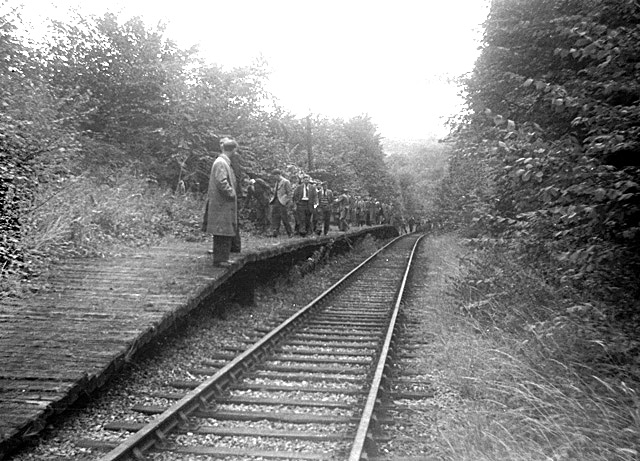
We managed to shorten our time in Brymbo station to only eight minutes, so set off for Minera at 5.30 pm, only three minutes behind schedule. This line had opened in July 1847 and is bedevilled with no less than nine level crossings and has gradients as steep as 1 in 39. Passenger services were introduced as far as Coed Poeth on 15th November 1897, extended to Berwig on 1st May 1905 and ceased altogether from 1st January 1931. We continued on the double track, past the Joint Junction, to Brymbo Middle Crossing (19m 48c) where the branch from Vron and the steelworks trailed in on the left. There were actually three tracks over the crossing and the box here was still in use. We passed through the site of Brymbo West Crossing Halt, box also open, and over the crossing to enter the single line at 19m 61c. The line beyond the halt was later to close from 1st January 1972, that up to the site of the halt followed on 1st October 1982.
After crossing the Caello and Smelt Crossings, the line becomes much more rural in character, with minimal earthworks. We passed Pentre Saeson halt (21m 22c) and Crossing and Gegin Crossing before pulling up for water at Coed Poeth station (21m 78c). Here there was a loop, the box was open and the station house was lived in. The guard had opened the gates for us, but we had to stop beyond the crossing to let him back on the train. We stopped at the site of Vicarage Crossing halt for the guard to do the honours, then off round curves which one Society member told the ‘Leader’ reporter "were the sharpest I have known a passenger train traverse in North Wales". We went through the Cae Glas Crossing just as the Minera shunter had got there first, but had to wait at the Berwig Crossing while he walked the 130 yards to open those gates. So we passed the site of the halt (22m 60c) and the termination of the regular passenger services to pull up at the entrance to the Minera Lime Works. We stopped just short of the trap points and past the trailing connection with the New Brighton branch, on the left, at 5.50 pm, distance covered so far 23m 5c. We were now eight minutes late; had we allowed enough time for taking water in our schedule, I wondered?
We all got out to explore, some of us walking the half mile through the sidings to reach the little one-road brick shed at a higher level on the left. Inside we found the Minera Lime Works‘ locomotive "Olwen", a Beyer Peacock 0-4-0ST of 1910. Then back to the train for the return journey to Wrexham. We had been allowed 18 minutes at Minera; we actually spent 22, so we were now 12 minutes behind. However, except for the stops to open the crossing gates, we had a clear run back, and pulled into Wrexham General just nine minutes late at 6.36 pm, having covered a total just two chains short of 30½ miles in 3 hours 33 minutes.
The report in the 'Wrexham Leader‘ concluded with an interview with one of the passengers, Mr B Roberts of Salford. After agreeing that the study of railways all starts way back in the nursery and that most boys find that their interest evaporates in early adolescence, Bernard sagely added "but once you let it get into your blood you are a lifelong addict". Our return tickets to Chester were available by either route, so some of us took the opportunity to have a ride over the WMCQ. There was ample time to walk into Wrexham and reach the Central station for the 7.25 pm departure to Seacombe.
We had ‘C14’ 4-4-2T No.67442 on our train as far as Shotton, where we dismounted to catch the connecting 8.10 pm to Chester, this time behind another 4-4-2T, ‘C 13' No.67426 which got us into Northgate at 8.32 pm. We had to then scurry round to the other platform for the 8.37 pm to Manchester, which had ‘D11 No.6266l "Gerard Powys Dewhurst" at the front. This got us back to Altrincham at 9.55 pm and to Manchester Central at 10.10 pm to round off a long but most enjoyable day.
For the record, the locomotives seen on Croes Newydd shed that lunchtime included the home based 0-4-2T 1410/73, 0-6-OPT 2183/85/86, 4617/45/83, 6404/05, 7403/43 and 9669, 0-6-2T 6610/94, 0-6-0 2259/97, 2-6-0 5319, 7310/13, 4-6-0 7823 "Hook Norton Manor", 2-8-0 2871, 3033. There were also three visitors, 0-6-0 2257 from Tyseley, 4-6-0 6807 "Birchwood Grange“ from Worcester and 2-8-0 2833 of Oxley shed. Note that our railtour engine, 6405, was on shed being prepared.
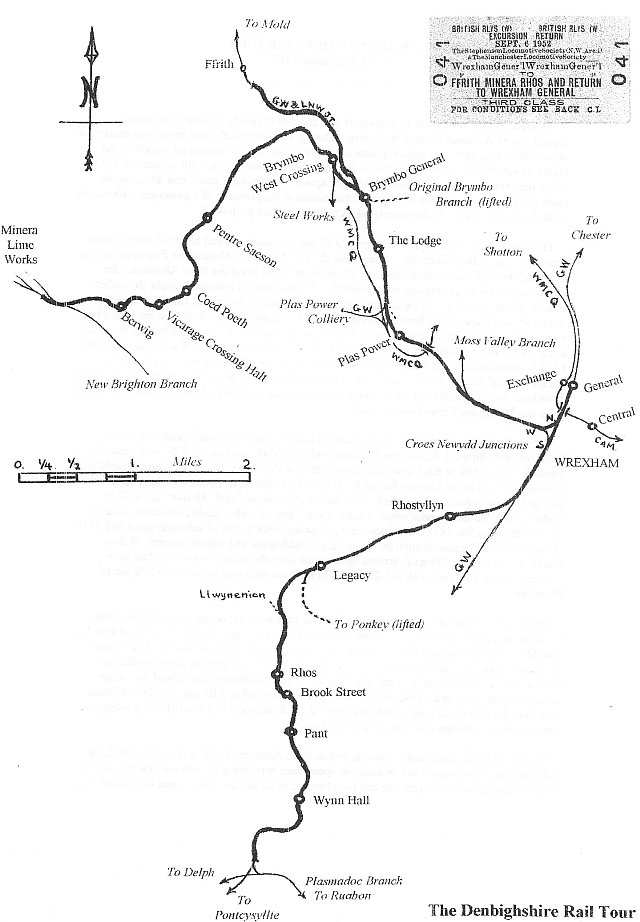
A map showing the lines covered by the railtour.
This account was originally compiled by
Bob Miller with additional information from Doug Darby,
who supplied all the train timings, and incorporated the
original railtour historical notes written by Gerald
Harrop.
The narrative for this article appeared in Issue No. 233 of the Society's magazine 'The Mancunian'. Photographs by Harold Bowtell/MLS Collection.
The narrative for this article appeared in Issue No. 233 of the Society's magazine 'The Mancunian'. Photographs by Harold Bowtell/MLS Collection.
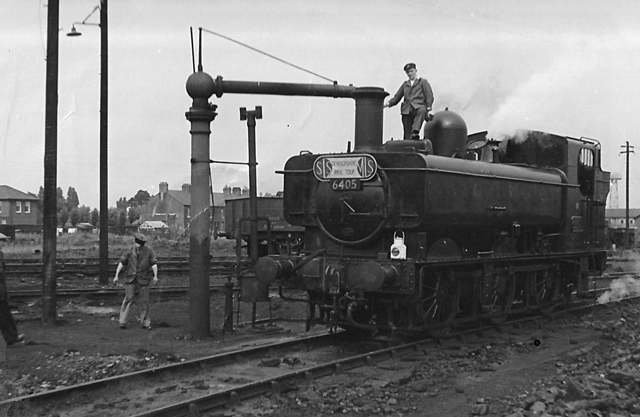
Photo courtesy of David Jones
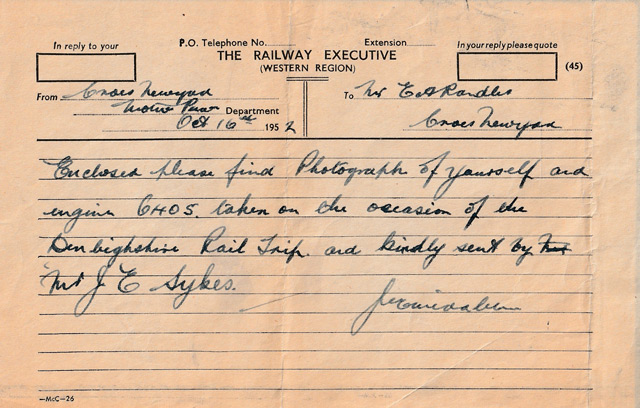
Photo courtesy of David Jones
Last update December 2021. Comments welcome: website@manlocosoc.co.uk